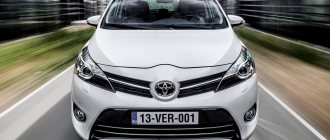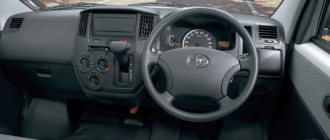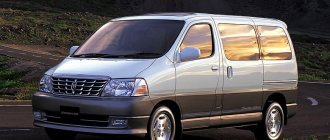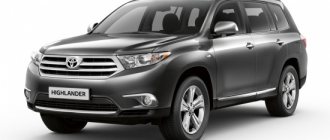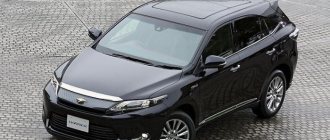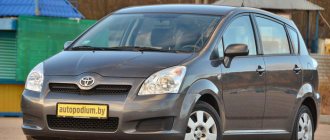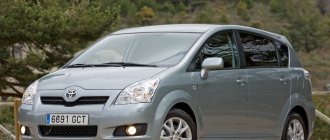Reviews of Toyota Corolla Verso Rating: 4.6 out of 5 37 reviews found
27.04.2009
I’ll say right away that the car is a year old and only about 16,000 km have been covered, so I don’t have a full impression yet, I haven’t encountered any repairs, but only the first one has been completed.
When I bought it I also considered: Opel - Zafira, Renault Grand Scenic, 5 Mazda, and Ford S-Max. I wanted a car for “all occasions,” maximally adapted to the city, maximum comfort for long trips, the ability to seat 7, reliable and practical. In my opinion, Toyota was responsible for all this! The price range in this configuration (I have Sol) of all these brands last year was not large + that year it had the only “automatic” for that period.
This unit is sold from official dealers only in two trim levels: Terra and Sol; in Terra you can play with “mechanical” or “Multimod” boxes, in SOL only “multimod”. Somehow, in modern conditions, all this is not very respectable for Toyota, if you look at the same Ford, where you can “stuff” the car as you want and at reasonable prices. Example: until last year, tinting the rear windshields was not included in Sol, I ordered it without this option, while I was waiting (about 3 months) for the car, it became part of the basic package and they asked me + 2000 rubles, and in the Toyota showroom for On Pulkovo Highway this pleasure cost 6,000 rubles. When I was tormented when buying between SOL and Terra + something to deliver, I realized that it’s easier to have a full set, you’ll save twice as much on the same options, if not three!
Although the Corolla Verso is positioned as a minivan, it is far from a real minivan; in the Toyota line, the Avensis Verso rather corresponds to this concept, but it is not sold at official dealers in Russia; The same thing has little in common with the Toyota Corolla, perhaps only the name, the box, and the crazy operation of the on-board computer (again about official dealers), in my opinion, calling Verso a Toyota Corolla station wagon is possible (for example, it’s written down in my insurance policy!), but also not entirely true. Those. This car is most likely closest to a compact van, i.e. something between a golf class and a minivan. Comparing the Corolla before 2004 and after, in terms of the engine and appearance of two different cars, the “old version” is more like a Corolla station wagon. Journalists about cars use this unit for comparison in compact vans, I saw a video where Verso was compared with Golf Plus, and here comparisons are appropriate. According to the literature, there is very little data about the Corolla Verso, for some reason the Toyota concern does not “promote” it, even in stock at official dealers it can rarely be seen in the showroom: of the three St. Petersburg ones, last year, it was only in one place in the exhibition version ... In terms of dimensions, it is clearly included in the B-class, which is just right for the city!
The appearance is unique: despite the seemingly small windows on the outside, the visibility from all seats is excellent, the large doors make it very comfortable to sit in, the car is tall, in my opinion, everything is to the point and nothing superfluous, all the lines are subordinated to “aerodynamics.”
In the cabin, everything is in place: 2 glove compartments + a “spectacles” compartment, many cup holders and compartments for small items, 2 sockets. The finishing materials are not the most expensive, but of good quality and quality. The rear seats are easily adjustable in angle, quite comfortable, legroom is no less than in the front, there is no partition on the floor.
Driver's seat: everything is at hand, everything can be reached, all the buttons are in place, some are annoyed that the mirror controls “have to be looked for”, it is on the far left on the console, but how often do you use it?... For example, I set the mirrors like this and I drive... The only thing that I personally don’t really like is the radio controls on the steering wheel. In my opinion, the steering column control is much more convenient. The driver's seat, I think is ideal, I've driven many cars, the only thing that reminds me of the RAV4, I don't take into account the anatomical seats (it's funny to read in the reviews, but I'm 200, and I'm 195 cm tall and I... it feels like the car section read only by giants) the seat lift is about 30 cm, which can provide both a sporty seat and a “stool”, for everyone. Visibility from the driver's seat is without blind spots, the pillars are located very well, unlike the same Zafira and everything is visible, the electrochromic rear view mirror is also not an extra gadget, despite its seemingly small size there is excellent visibility and no one will be blinded at night. I don’t understand where the complaints about the dashboard come from, the calm color scheme is blue, 4 or 5 brightness settings, two are enough for me. The MP3 radio reads without problems, well, it doesn’t automatically hold the wave... The separate “climate” is good, maybe a little thoughtful in cold weather, but in automatic mode it’s quite reasonable. The most basic feature of the car is the possible modifications of its interior, as 32 of them write, it seems they are not deceiving. The interior can be “adjusted” to your goals and objectives in a minute; all second-row seats have folding backrests and are autonomous and on skids. With my height of 177 cm, with the 2nd and 3rd row seats folded down, I can sleep without discomfort with my legs fully extended. The 3rd row of seats is not for long trips, but the kids live there with pleasure. And frankly speaking, with the 7-seater version there is almost no “trunk”, so when traveling it is wiser to count on 6 seats, or to go with almost no luggage.
The driving qualities of the car are not Formula 1, but in the city there are no problems, with a smooth ride and the consumption of kerosene is not high and the work of the robotic gearbox is not noticeable, it handles in traffic like a native one. If you really want to be Schumacher, there is a sports mode button and then... what is written in the specifications is that on multimode up to 100 in 12 seconds is clearly faster..., however, he loves the kerosene stove... “Rolling” without problems, absolutely obedient to the steering wheel, it is clear that “ exchange rate stability" is worth it for a reason. The brakes are the same at 5! The only thing I didn’t like was braking on ice, there was an unpleasant kickback to the leg, which was scary at first. The suspension absorbs almost everything, is moderately stiff, so that the passenger falls asleep in it very quickly, “tested on people”, there is something worthy of comparison.
Of course, a separate article is the robotic box. At first the impression is frightening: you press the accelerator pedal... it’s empty and then suddenly it jerks... The transition was difficult, for the first 1500 I drove only “mechanics”, but after human units, especially when you drive here and there, it was still not possible to switch gears automatically . Therefore, at one fine moment I simply surrendered to the car... and when I understood its intentions, everything became without problems, the car reacts quite adequately to pressing the accelerator pedal, when overtaking on the highway there is a delay of about a second, since the car itself chooses its own speed for overtaking… then it’s up to the engine… and it’s very, very good!
The engine in the car is excellent: it has its own “horses”, pulls, and in some ways resembles a diesel engine. Somewhat noisy after 120 km per hour. The speed picks up smoothly without dips, there are no “dead zones”. On the highway it responds well to the accelerator. It consumes about 10-11 liters in the city in summer, 11-12 liters in winter (although all these data are peculiar, what is considered a city?..., driving in the city center, where the average speed is no more than 10 km per hour, there are up to 14 liters in winter it reaches a hundred or on weekends on the outskirts, where the consumption does not exceed 9 liters! - this is St. Petersburg); on the highway it all depends on the speed from 6 (90 km per hour) to 8 liters (130 and above), but since there are problems of a different nature, this is all very relative! For the second year in a row, the device seems to not perform its functions - long trips (St. Petersburg - Black Sea), so I won’t be able to report on super trips, and 200-500 km from the city, this is a slightly different calico. Reviews about the previous 1.8 engine, on Corolla Verso cars before 2004, due to improper oil circulation, the engine died after 60,000, according to the words, this defect has been corrected.
The only thing that really irritates me in the car is the operation of the on-board computer, what does it think there? The real numbers on it are mileage, time, travel time and temperature outside. Everything else is nonsense, the Japanese are clearly too smart to measure the average consumption per tank (this has never happened since the device itself dumps the data in random order, the speed for one trip! What kind of data? Where should I put it? Moreover, you can duplicate three the same thing over and over again! What he is sculpting there is probably known only to the great Japanese mind! Measured how much kerosene is left and for what distance it will be enough, according to the onboard and even more sharply: the light comes on when there is still kerosene in the car for 100-150 km Positioning the car as economical is great!
A little about small things. The “dokatka” is easy to get, riding on it is also no problem, the elevator on which goes down takes about a minute and a half. The sliding shelf above the trunk is easy to install, but it’s a hassle to fold it and put it back! To be honest, it is not needed at all; taking it out will free up space for small things, such as keys. To install the jack, you need to know the place where it is placed. It’s a cool cruise control function, but in the vicinity of St. Petersburg it’s practically impossible to use it, except along the Ring Road. A convenient key is a key fob, it also contains the key for the glove compartment and doors!
What I would like from a Toyota Corolla Verso: more intelligent (faster) operation of the box, a normal on-board computer, and it wouldn’t be bad to have a light sensor in the basic configuration!
Review of Toyota Verso AT: a car for girls
First: some people advise buying manual ones, and this is with a height of 187 cm. I wonder what size the boots are? For example, I’m 193 cm, and my boot size is 48, and accordingly it will take both pedals together, and since I don’t have a driver’s license, I’m not accustomed to pressing the brake and gas at the same time. Yes, Toyota Verso is a car for girls, of course. I bought it for my beloved, but I only travel by myself.
Second: about the box. I went through the fourth maintenance at the center on Piskarevsky, and accordingly I drove a relatively long distance, but I absolutely can’t get used to the box. I think it's about the person, not the box.
So forty years ago I began my life as a driver in a railway battalion driving a GAZ-51 in the Mikhailovsky district of the Amur region. Now, in extreme situations, I do a second spin, receive no response from the box and become covered in wet sweat. Those who drove a GAZ-51 will understand me.
Review of Toyota Verso restyling 2012
My brother had a pre-restyling version at that time, so there was something to compare it with. The restyled version has become more expensive to maintain, and changes have been made to the trunk for the worse. The suspension, especially the rear beam, is problematic; the car seems rigid.
Overall, of course, the car is still excellent, excellent ease of operation of the steering wheel. I even had to get used to it and calculate the forces correctly, since the control is barely noticeable physically.
The car's interior is quite stylish, but the arrangement of the instrument panel is unusual. Although in the end I quickly got used to it.
Overall, the Verso still proved to be a high-quality and reliable car for families and long trips.
Toyota Verso real fuel consumption per 100 km: reviews
Motor 1.6
- Ilya, Kostroma. I have a Toyota Komplektazo 2011, first generation. The compact van was purchased for family needs. I have a five-seater configuration with a 1.6-liter. engine and manual transmission. The car is in the middle variation, the interior brings to mind the Toyota Corolla from the inside. In the end, not a bit unusual. Gray finishing materials somehow calm you down and set you up for a leisurely ride. This can be said about 130l. With. 1.6 l. power unit. It consumes 9-11 liters in urban areas. In the extra-urban cycle it comes out to 4-8 liters per hundred kilometers.
- Vladislav, Syktyvkar. A wonderful family car, I read a ton of reviews before purchasing it. I have a Toyota Komplektazo of the second generation, a car in the maximum variation with a pre-premium power unit with a working size of 1.6 liters - it produces 130 forces and consumes 9-11 liters in urban driving. Behind the pride comes 8 liters
- Maxim, Omsk. I like everything about this car - from its appearance to its driving character. It is clear that not everyone will like this look. However, thanks to this hull shape with a high roof, the interior is very comfortable and spacious in all directions, especially overhead and in the knee area for the rear people. Powerful 1.6-liter. The power unit with an automatic transmission produces 130 forces, but somehow you don’t feel them. The engine produces no more than 100 horsepower. Apparently, the robot takes away part of the maximum power. However, the fuel consumption level does not exceed 11 liters per hundred kilometers, and this satisfies me.
Toyota Verso engines. Official fuel consumption per 100 km.
Generation 1 (2009-2012)
Gasoline engines:
- 1.6, 132 hp. power, manual transmission, front-wheel drive, 8.6/5.8 consumption
- 1.8, 147 hp power, gearbox: variator, front-wheel drive, 8.9/6 consumption
- 1.8, 147 hp power, manual transmission, front-wheel drive, 9/5.8 liters per hundred kilometers.
Generation 2 (2012-present)
Gasoline engines:
- 1.6, 132 hp power, manual transmission, front-wheel drive, 8.3/5.6 consumption
- 1.8, 147 hp power, gearbox: variator, front-wheel drive, 8.5/5.8 consumption
- 1.8, 147 hp power, manual transmission, front-wheel drive, 8.7/5.7 liters per hundred kilometers.
